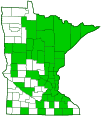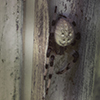shamrock orbweaver
(Araneus trifolium)
Conservation • Description • Habitat • Biology • Distribution • Taxonomy
|
|
||||||||||||||
Description |
There are about 650 species in the genus Araneus. Shamrock orbweaver is the largest of these in Minnesota. It occurs across the United States and Canada. It is common in Minnesota. Its large, vertical, circular web is found between between plants, often goldenrods, between 20″ to 80″ off the ground. The female is ¼″ to ¾″ (6 to 20 mm) in length. The male is much smaller, ¾″ to 19 ⁄16″ (20 to 40 mm) long. The front part of the body (cephalothorax) of the female is medium length to long. The hardened plate (carapace) covering the cephalothorax is light brown with a black stripe in the center and another on each side. The back part of the body (abdomen) is oval to spherical. It has no humps and no angles toward the front. The upper side of the abdomen highly variable in color and may be light, medium, or dark. It is often reddish but may be purplish, greenish, brownish, or off-white. There are numerous angular white spots and four small, round, black spots. The black spots are always paired with white spots. On medium and dark specimens, the white spots are bordered with a contrasting dark color. On light specimens they are not visibly bordered. The legs are light brown and medium length to long. They have many conspicuous, highly contrasting, dark bands. The male has a smaller and has a narrower abdomen and longer legs. |
Size |
Female Body Length: ¼″ to ¾″ (6 to 20 mm) Male Body Length: 3 ⁄16″ to ½″ (5 to 13 mm) Legspan: ¾″ to 19 ⁄16″ (20 to 40 mm) |
Web |
Similar Species |
Habitat |
Tall grasses, shrubs, and trees in meadows and woodland edges; gardens, eaves of buildings, and fences |
Biology |
Season |
Mature spiders from August to October |
Behavior |
The female spins a large circular web that hangs vertically. This web is called an “orb”, which gives this family of spiders its common name. The orb is typically a closed hub, 20″ to 30″ in diameter, with 15 to 35 spokes (radii) that are not sticky. The radii extend to the center of the hub. They are connected to each other by sticky threads that spiral outward from the center. The spider also makes a retreat out of silk near one edge of the orb. The retreat is connected by a signal thread to the center of the web, allowing the spider to feel vibrations of prey. The spider spends much of its time in the retreat, especially in the hot midday hours. The web is usually consumed and a new web constructed each evening. Females catch medium-sized and large insects, even insects larger than themselves. They ignore smaller insects. Males are not able to catch prey larger than themselves. |
Life Cycle |
Several hundred orange eggs are deposited in a mass and then wrapped in silk producing a flattened spherical egg sac about 1″ in diameter. The egg sac is then attached to nearby vegetation or to the spider’s retreat. Some eggs hatch in the fall, others overwinter in egg sacs. Spiderlings disperse by “ballooning”. They climb a branch, blade of grass, or fencepost, and release a long thread of silk. The silk thread catches the wind or even a light breeze and the spiderling floats to a new site. |
Food |
Large and small flying insects |
Distribution |
||
|
Sources |
|
| 8/7/2025 | ||
Occurrence |
||
Common and widespread |
||
Taxonomy |
|
Class |
Arachnida (arachnids) |
Order |
|
Suborder |
Araneomorphae (typical spiders) |
Infraorder |
Entelegynae |
Superfamily |
Araneoidea (orbweavers and allies) |
Family |
|
Subfamily |
Araneinae (typical orbweavers) |
Genus |
Araneus (angulate and roundshouldered orbweavers) |
Subordinate Taxa |
|
|
|
Synonyms |
|
Aranae trifolium Araneus gosoganus Araneus septimus Araneus trifolium ssp. candicans |
|
Common Names |
|
pumpkin spider shamrock orbweaver shamrock spider |
|
Glossary
Carapace
The hard, upper (dorsal), shell-like covering (exoskeleton) of the body or at least the thorax of many arthropods and of turtles and tortoises. On crustaceans, it covers the cephalothorax. On spiders, the top of the cephalothorax made from a series of fused sclerites.
Cephalothorax
The front part of a spider’s body, composed of the head region and the thoracic area fused together. Eyes, legs, and antennae are attached to this part.
Visitor Photos |
||
Share your photo of this arachnid. |
||
This button not working for you? |
||
Sarah Best |
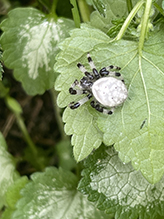 |
Debra Simpson |
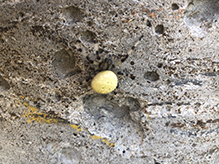 |
Alfredo Colon |
||
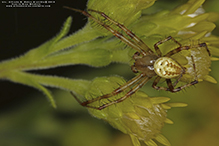 |
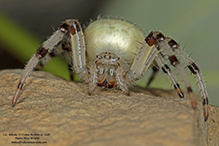 |
|
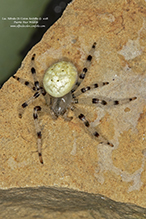 |
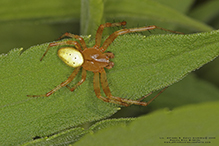 |
|
Samantha Reigel |
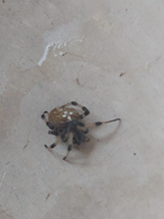 |
Jessica Torres |
||
on my frontdoor 10/3/2021 |
||
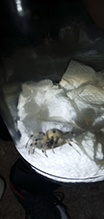 |
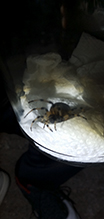 |
|
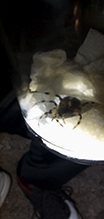 |
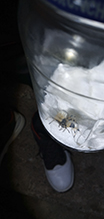 |
|
Julie Swanson |
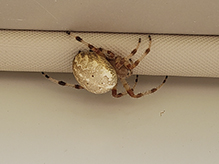 |
Found in the doorway of my husband's hunting shack when my head ran into the web. Ew. |
Katie Schmidt |
||
I first observed 'Lilith' on July 25th. She has taken up residence on the door of our back deck. My family and I have been watching her, daily, and she has become like a family member! My 4 year-old, my 13 year-old, and my husband all thought I was crazy for becoming attached to her, but now they are, too! Attached are some photos we've taken since we realized we were sharing a living space. |
||
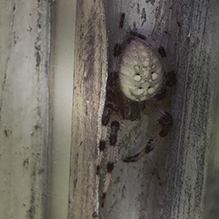 |
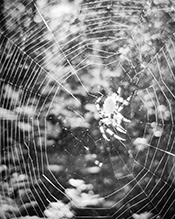 |
|
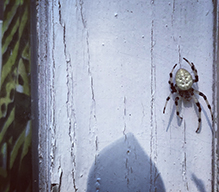 |
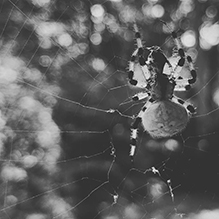 |
|
MinnesotaSeasons.com Photos |
||
|
||
|

Slideshows |
|

Visitor Videos |
||
Share your video of this arachnid. |
||
This button not working for you? |
||
Sarah Best |
shamrock orbweaver 01 |
About
shamrock orbweaver (Araneus trifolium) Brigham Farm, Blue Mounds WI 8/7/2025 Video by Sarah Best |
Other Videos |
||
Fall Hunt For Large Shamrock Spider |
About
Published on Sep 30, 2013 Well, I went out to a new prairie in search of the Shamrock orb-weaver spider (Araneus trifolium) as I have not been able to find a single one in my regular places I visit. But I was successful and had a nice hunt and found my prize spider! Brought a couple home for some more filming and then will be returning them to their webs. |
Araneus Trifolium Takes On Large Bumblebee |
About
Published on Aug 27, 2015 Funny thing... The bumblebee is so large, and the shamrock spider is so (for lack of a better term) fat, she was struggling to wrap up this bee... So instead, she gives up wrapping and gives it a single venomous bite for 20 minutes until the bee is finally dead. I've been bit by these spiders a couple times (Yes, it was entirely my fault... Don't handle them roughly like I did), and it is not pleasant! They have a lot of power in those fangs! |

Visitor Sightings |
||
Report a sighting of this arachnid. |
||
This button not working for you? |
||
Sarah Best |
Location: Brigham Farm, Blue Mounds WI |
 |
Daniela Bosanska |
Location: Hundested, Denmark |
|
John Valo |
Shamrock orbweaver does not occur in Europe. What you saw may be the four-spot orbweaver. It is very similar to in appearance shamrock orbweaver, and it is very common in Denmark. |
|
Debra Simpson |
Location: Wayzata, MN |
Samantha Reigel |
Location: Deer River, MN Found in our lilac bush |
Jessica Torres |
Location: Cloquet MN, Carlton Co., FDL REZ crazy looking had ex take it |
Julie Swanson |
Location: St. Louis County, Buick, MN Found in the doorway of my husband's hunting shack when my head ran into the web. Ew. |
| Katie Schmidt 7/25 - 8/15/2020 |
Location: Nisswa, MN I first observed 'Lilith' on July 25th. She has taken up residence on the door of our back deck. My family and I have been watching her, daily, and she has become like a family member! My 4 year-old, my 13 year-old, and my husband all thought I was crazy for becoming attached to her, but now they are, too! Attached are some photos we've taken since we realized we were sharing a living space. |
| Alfredo Colon 9-3 to 9-5-2019 |
Location: Woodbury, MN |
| Alfredo Colon 8/13/2019 |
Location: Woodbury, MN |
| Alfredo Colon 8/12/2018 |
Location: Woodbury, Minnesota |
MinnesotaSeasons.com Sightings |
||
|

Created: 4/25/2019 Last Updated: © MinnesotaSeasons.com. All rights reserved. |
